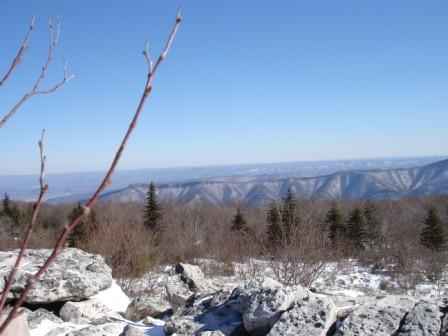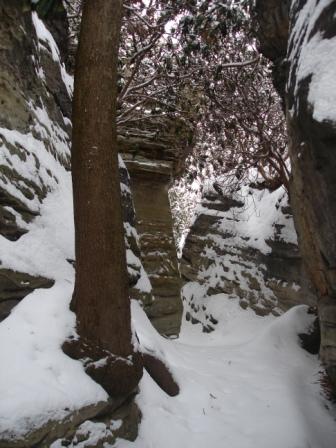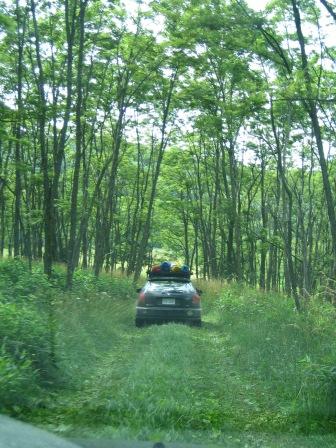It's about time I write about my favorite spot in the state, located at roughly 38°59′45″N, 79°22′05″W. It is the location of the Dolly Sods Wilderness, a part of the Monongahela National forest. Not surprisingly, Wikipedia is a better reference for information about the area than even the state's website. Here is that link.
I've visited the area nearly a dozen times in two years, thanks in majority to our good friends and neighbors, Mark and Margot, who own a cabin just below the ridgeline on an island of private property. Being a primitive cabin, its impact on the forest is minimal, as it should be. The Wilderness, really a high elevation plateau (East Coast high, that is, at about 4000 ft.), has a history of public use starting with WWI training grounds. The 101st Mountain Division was located a few ridges over at Sececa Rocks at that time, and Dolly Sods became a bomb testing ground. Before that, farming and seasonal livestock grazing were the only use of this land. I only point this out to emphasize the fact that this region has been isolated from civilization for a long, long time, and is still a very remote area.
In January of 2005, I finally was able to take Mark and Margot up on their offer to visit the cabin. It had been a mild winter, and it was in the 40's in DC at the time, so it seemed like it wouldn't be too much of a problem to go. I was told by Mark, however, that getting there at night isn't a good idea for my first time, if I was able to get up the forest road to begin with. No problem, I told him, we'd arrive during the day, and we'd recruited Jeremy (there he is again . . . ) to drive in his Wrangler. (Note to self: it sounds like I might want a Wrangler).
With detailed directions in hand, we took off for the cabin on a Friday. Kirsten would drive up the following morning, making this recon. It's a pretty good feeling to be doing recon. It would take about 3 hours to get there, and the last five miles were more orienteering than they were following a road map. "After the second hairpin, look for the gate," "When you think the driveway turns left, go straight through the brush."
Well, the directions were fine, and we only had to turn around once. This however, was not your ordinary U-turn. While still in the valley, just as we turned off the paved road, it was raining lightly with no snow to speak of. We had stopped at the riverbank and filled the Wrangler (in and on) with a ton of dry driftwood for the night. To our surprise, in under 3 miles up the forest road, we progressively found ourselves driving through about 8 inches of powder, following a set of tracks that couldn't have been older than a day. The Jeep handled famously after Jeremy dropped into 4WD, and I called out landmarks as they came. Just as we came upon a neighboring cabin that we were told indicated that we'd past the gate, the tracks we were following stopped. "We went too far," I said, and Jeremy stopped the Jeep. "Good, I liked following those tracks."
Making a 3-point turn, or even a U-turn in a Wrangler is easy, right? Well, little did we know that there were deep ditches on both sides of the narrow forest road, but their existence was masked because they were filled with snow. We were looking at a white road with a nice shoulder perfectly level with the road surface, or so we thought. Down into the ditch went the passenger side of the Jeep, jarring both of us, and revealing a precarious situation. After dozens of off-road experiences with Jeremy behind the wheel of a Wranger, he finally found his Jeep stuck.
I let him come up with a plan for the Jeep while I walked back down the road to see if we were actually where I thought we were. We were. I opened the gate, and shouted, "We're here!" All we had to do now was to get the Jeep unstuck and travel the half-mile long driveway, which hadn't seen a vehicle since before the snow.
Getting the Jeep unstuck eventually required shovels, roof tiles (all retrieved by walking to the cabin), and lots of umph, but we got it out. Driving to the cabin was relatively easy, and behold, we were in the right place.
In dozens of camping and cabin trips, I've never had to use a fire to keep the crew warm through an extremely cold night, and neither had Jeremy. Needless to say, I woke up several times soaking in sweat, only to wake up two hours after that freezing cold. I'd groan something across the cabin, like, "Dude . . your turn," and Jeremy would go fill up the stove with wood, but only after trying to convince me that it was my turn. I finally figured it out recently, but it's not nearly as easy as, load the woodstove, flame on, rub hands gently to warm. This method eats firewood at an alarming rate, especially if you took it from a heap of driftwood that has the feel of Balsa.
When the two of us woke up at dawn, the Jeep had about 6 inches of fresh snow on its roof and hood. This place gets an incredible amount of snow, and the wind likes to blow it into enormous drifts. Mark told me about a time some years ago when he got his Cherokee stuck, threw the tire chains, and started walking. At each headwall in the road, the drifts were above his head, and so he had to resort to his Army training technique of first throwing his pack over the drift, and then rolling himself over it in order to maximize his surface area and distribute his weight.
Based on Mark's warnings about these snowdrifts, fight lost to flight in our case, and Jeremy and I packed up the Jeep and headed down the mountain. The treat of the weekend was the drive down the forest road through a complete winter wonderland. The tracks we were following yesterday, as well as our own tracks, were not even visible under the blanket of fresh snow. Despite the frigid air, we rolled down the windows for the accoustic effect anybody who's been in a snow-covered forest knows well. We drove about 4 miles per hour, and only partially to be safe.
Five road-miles away and 2000 feet below in the valley, it was still raining, not a flake to be seen. I have many more memories of this place coming in future posts.
Git 'r Dun.
The Motivation for this Journal
My name is Matt and I play in West Virginia. Actually, I'm addicted to the state.
Living inside or within a few hours of a WV state border for all of my life, I've had plenty of "West Virginia Moments," a characterization that could range from WV stereotype reinforcements of the cultural (could be bad) to the natural persuasion. Fortunately, the number of the latter is far greater than the number of former.
I wish to document with this blog these "West Virginia Moments." If you're reading this, then you are a friend or family member, or have stumbled upon this blog, and I thank you for reading and hope you'll get a laugh, discover a new natural place in WV, or gasp at the thought of it. However, the real reason for this blog is personal. I will consider this blog an archive of these moments for a man with a poor memory.
Enjoy!
Living inside or within a few hours of a WV state border for all of my life, I've had plenty of "West Virginia Moments," a characterization that could range from WV stereotype reinforcements of the cultural (could be bad) to the natural persuasion. Fortunately, the number of the latter is far greater than the number of former.
I wish to document with this blog these "West Virginia Moments." If you're reading this, then you are a friend or family member, or have stumbled upon this blog, and I thank you for reading and hope you'll get a laugh, discover a new natural place in WV, or gasp at the thought of it. However, the real reason for this blog is personal. I will consider this blog an archive of these moments for a man with a poor memory.
Enjoy!




